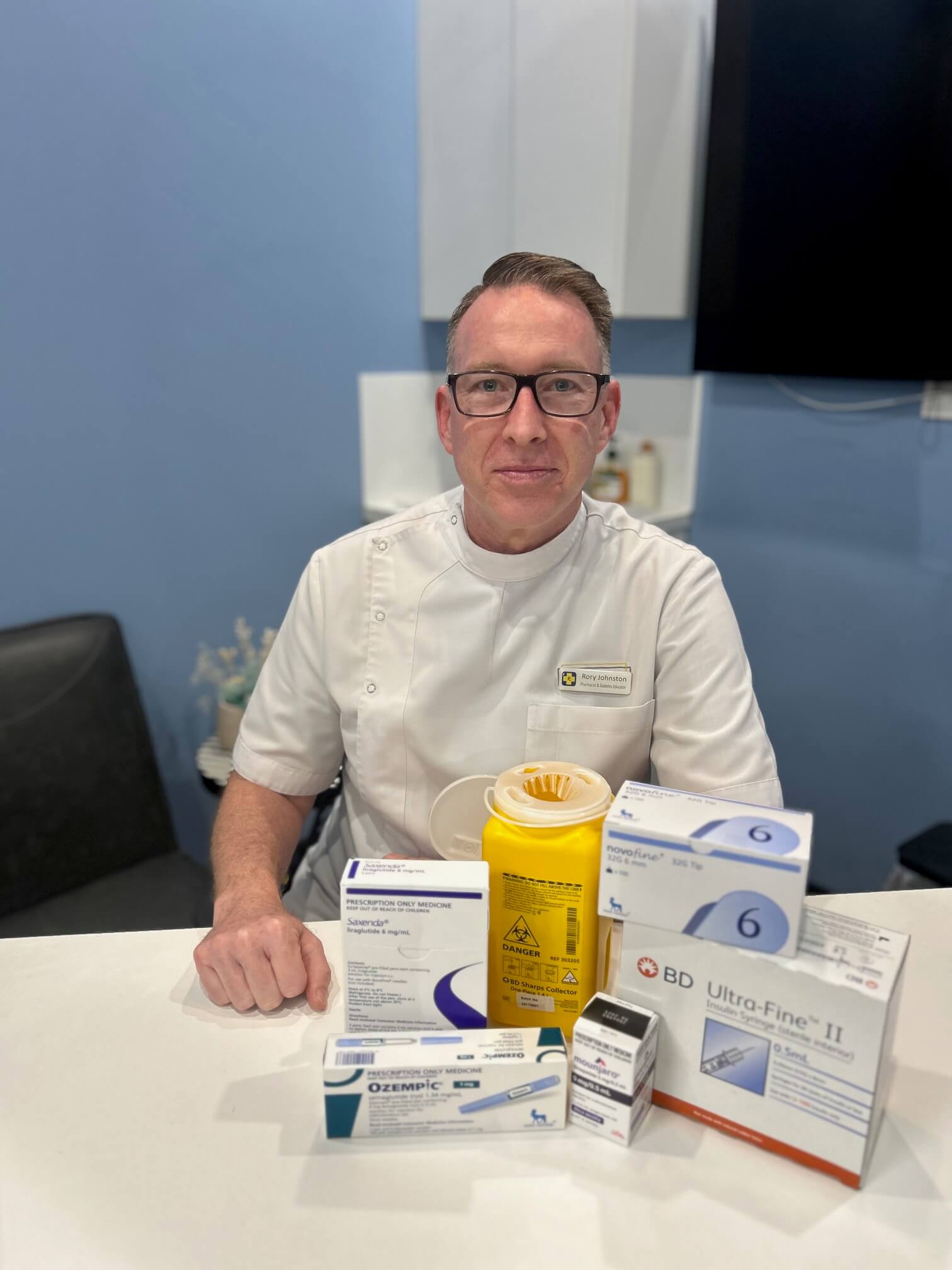The landscape for glucagon-like peptide-1 receptor agonists (GLP-1RAs) used for weight loss is changing in Australia as demand continues to grow.
Australian Pharmacist explains what options are available, and restricted, for weight loss patients.
Ozempic is out of stock … again
There is no end in sight to the Ozempic shortage, with Novo Nordisk recently informing the Therapeutic Goods Administration (TGA) that supply of the medicine will remain limited for the rest of 2024.
The TGA has continued to ask prescribers not to initiate new patients on Ozempic unless there are no suitable alternatives, with supplies prioritised for patients with type 2 diabetes who are stabilised on the medicine.
Patients who have been using the medicine for weight loss should potentially be switched to an alternative, such as Wegovy which is approved for this indication.
In the experience of Brisbane-based community pharmacist and diabetes educator Rory Johnston MPS, the persistent Ozempic shortages have led to patients seeking the medicine for weight loss being treated with ‘great contempt’ by some healthcare professionals.

There is often a perception that people are simply overweight due to overeating, said Mr Johnston, but there are myriad conditions and medicine classes that can cause patients to gain weight, including:
- polycystic ovarian syndrome
- hypothyroidism
- cushing syndrome
- menopause
- depression
- antipsychotics such as olanzapine
- anti-seizure medicines such as valproic acid
- antidepressants such as mirtazapine/venlafaxine.
‘I had one customer with a metabolic disorder being told by a pharmacist she’s the reason people with diabetes are dying,’ he said.
‘I’d like to see these people being able to source suitable treatment without the stigma and the cost burden just because they don’t have a type 2 diabetes diagnosis.’
Is Wegovy a suitable alternative?
Wegovy, a semaglutide product indicated specifically for weight loss, was approved for inclusion on the Australian Register of Therapeutic Goods (ARTG) in 2022 – but it took 2 years to hit the Australian market.
Released in Australia in August 2024 in prefilled single-dose pens and prefilled Flextouch multi-dose pens, Wegovy is available in the following strengths:
- 0.25 mg
- 0.5 mg
- 1 mg
- 1.7 mg
- 2.4 mg.
Evidence shows that Wegovy can help patients achieve long-term weight loss, with a recent study over a 4-year period leading participants to achieving an average weight loss of 10.2% body weight.
But the cost of the medicine, which is not subsidised under the Pharmaceutical Benefits Scheme (PBS), is prohibitive to many patients. When used at the recommended maintenance dose (2.4 mg once weekly), a private prescription can set patients back around $460 per month for the Flextouch formulation.
This is particularly jarring when compared to the price of a private script of Ozempic, which ranges from around $150–$170 per month, said Mr Johnston.
The highest dose of Wegovy exceeds that of Ozempic (2.4 mg versus 1 mg weekly). ‘But if we are talking mg to mg of an identical product, it’s double the retail price,’ he said.
‘This [essentially] tells customers their condition isn’t as [important].’
While Mr Johnston said a few patients have ‘trickled through’ with scripts for Wegovy, they are typically surprised at the price difference.
‘They know about Ozempic or have used Ozempic, so when they learn about the price of Wegovy, it’s a big shock,’ he said.
But thus far none of Mr Johnston’s patients are on the highest strength.
‘Some patients experience vomiting and diarrhoea on the 1 mg Ozempic dose, so [it remains to be seen] how many are going to transition up past 1 mg of Wegovy to 1.7 mg or 2.4 mg,’ he said. ‘I think that’s probably going to be a smaller cohort of patients.’
Mounjaro is now available in a pre-filled pen
When Mounjaro (tirzepatide) was listed on the ARTG in July 2023, it was indicated for type 2 diabetes, and released in single-dose vials for patients to self-administer subcutaneously.
Mounjaro has been previously prescribed off-label to patients for weight loss via private prescription, with prices for the initiation dose beginning at $395 per month.
However, last month (September 2024), the TGA approved Mounjaro for use as a treatment for chronic weight management in obese or certain overweight patients, but this new indication still requires a private prescription.
Because of this expense, some patients were advised to use the single-dose vials for multi-dose administration, which could lead to contamination and significant dosing errors.
A dual long-acting glucose-dependent insulinotropic polypeptide (GIP) and GLP-1 receptor agonist, Mounjaro works on an additional mechanism to the GLP-1RAs and increases insulin release, improves insulin sensitivity, delays gastric emptying to slow the absorption of glucose and reduces the appetite. The additional mechanism of action makes it a useful option for patients who have plateaued on semaglutide and are receiving no further weight loss benefits.
But both the high price, along with the mode of administration with the single-dose vials has been off-putting to many patients, thinks Mr Johnston.
Furthermore, most patients only find out how they need to subcutaneously inject themselves from a vial when they come into the pharmacy.
‘That’s when they learn it’s in a vial, they have to buy needles to draw it up and inject it themselves, and they need a sharps container for needles,’ Mr Johnston said. ‘Prescribers aren’t always forthcoming with that information.’
Patients who have been using the single-dose vial formulation of Mounjaro can now benefit from the release of the multi-dose pre-filled KwikPen, particularly as supplies of the single-dose vials remain limited.
‘With the ready-made pens, you press the button, it dials down, and you’re done,’ he said. ‘Whereas with the [single-dose vials] there are a few more steps involved.’
‘To improve the supply situation, Eli Lilly Australia has commenced a transition period in which Mounjaro single-use vials will be replaced with Mounjaro multi-use KwikPen,’ Eli Lilly said.
‘The KwikPens will make counselling customers regarding ease of administration easier and alleviate a lot of needlephobia. But if the price isn’t going to come down, I don’t think the change from vials to KwikPens will necessarily lead to an increase in uptake,’ added Mr Johnston.
Liraglutide is about to become cheaper
Some earlier generation GLP-1RAs, such as Byetta and Bydureon, have been discontinued. While patents on liraglutide, sold as Victoza and Saxenda, have now expired internationally – with manufacturers such as Sandoz formulating generic versions – there are still valid patents for both brands in Australia.*
The price of liraglutide, indicated for weight loss, is around $400 per month. This cost, combined with a daily dosing regimen, has rendered the medicine a less appealing option to patients – with no shortages of Victoza and Saxenda listed on the TGA Medicine Shortage Database.
In January 2024, Sun Pharma ANZ submitted an application to the TGA for the generic product Liraglutide Sun, Liraglutide RBX, Solleen – indicated for weight management.
‘[Liraglutide] is a once-daily [treatment] and the weight loss is good but modest compared with what we have now,’ said Professor Sof Andrikopoulos, CEO of the Australian Diabetes Society.
‘But I do think that if they are approved by the TGA, and the pricing is favourable, that they will be taken up as there will be a demand for them.’
For more information, refer to:
- the Australian Pharmaceutical Formulary and Handbook Weight management treatment guideline
- the PSA CPD Weight loss management.
*This article was amended on 10 October 2024 to include a correction that patents for Victoza and Saxenda are still valid in Australia.






 Grace Quach MPS[/caption]
Grace Quach MPS[/caption]






